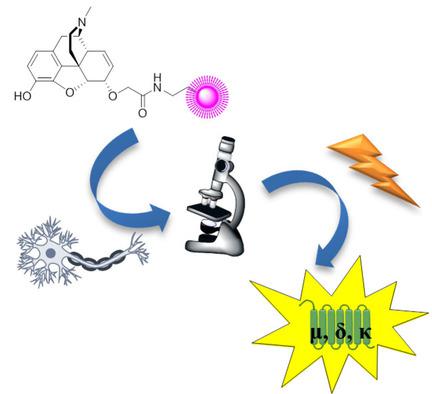当前位置:
X-MOL 学术
›
ChemPlusChem
›
论文详情
Our official English website, www.x-mol.net, welcomes your feedback! (Note: you will need to create a separate account there.)
Development and Biological Applications of Fluorescent Opioid Ligands.
ChemPlusChem ( IF 3.4 ) Pub Date : 2020-06-29 , DOI: 10.1002/cplu.202000212 Antonios Drakopoulos 1 , Michael Decker 1
ChemPlusChem ( IF 3.4 ) Pub Date : 2020-06-29 , DOI: 10.1002/cplu.202000212 Antonios Drakopoulos 1 , Michael Decker 1
Affiliation

|
Opioid receptors (ORs) are classified among the oldest and best investigated drug targets due to their fundamental role in the treatment of pain and related disorders. ORs are divided in three conventional subtypes (μ, κ, δ) and the non‐classical nocicepetin receptor. All ORs are family A G protein‐coupled receptors (GPCRs), and are located on the cell surface. Modern biophysical methods use light to investigate physiological processes at organismal, cellular and subcellular level. Many of these methods rely on fluorescent ligands, thus highlighting their importance. This review addresses the advancements in the development of opioid fluorescent ligands and their use in biological, pharmacological and imaging applications.
中文翻译:

荧光类阿片配体的开发及其生物学应用。
阿片类药物受体(ORs)由于其在治疗疼痛和相关疾病中的基本作用而被归类为最古老和研究最好的药物。ORs分为三种常规亚型(μ,κ,δ)和非经典Nocicepetin受体。所有OR均为AG蛋白偶联家族(GPCR)家族,位于细胞表面。现代生物物理方法使用光来研究生物,细胞和亚细胞水平的生理过程。这些方法中许多都依赖于荧光配体,因此突出了它们的重要性。这篇综述阐述了阿片样物质荧光配体的发展及其在生物学,药理学和成像领域的应用。
更新日期:2020-06-29
中文翻译:

荧光类阿片配体的开发及其生物学应用。
阿片类药物受体(ORs)由于其在治疗疼痛和相关疾病中的基本作用而被归类为最古老和研究最好的药物。ORs分为三种常规亚型(μ,κ,δ)和非经典Nocicepetin受体。所有OR均为AG蛋白偶联家族(GPCR)家族,位于细胞表面。现代生物物理方法使用光来研究生物,细胞和亚细胞水平的生理过程。这些方法中许多都依赖于荧光配体,因此突出了它们的重要性。这篇综述阐述了阿片样物质荧光配体的发展及其在生物学,药理学和成像领域的应用。



























 京公网安备 11010802027423号
京公网安备 11010802027423号